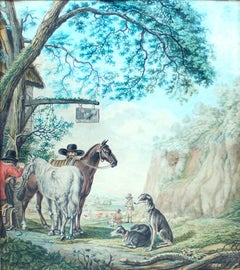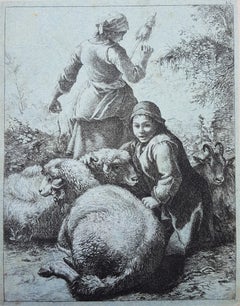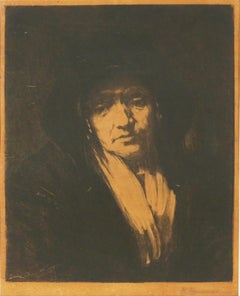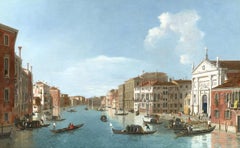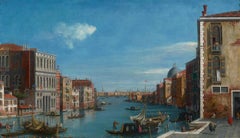18th Century and Earlier Art
Period: 18th Century and Earlier
Color: Blue
Circa 1970 photo poster of Surf by photographer LeRoy Grannis - Huntington Beach
Located in PARIS, FR
Beautiful photo poster of Surf by photographer Leroy Grannis. Huntington Beach is a coastal municipality of Orange County, located in the southern part o...
Category
18th Century and Earlier Art
Materials
Paper
Study of a girl sitting and reading a book
By William Hoare
Located in Bath, Somerset
A study in red chalk of a girl sitting and reading a book. Red chalk on paper under glass in a giltwood and gesso frame. This small drawing has a sense of intimacy in the capturing of a moment where the sitter is seemingly unaware of being observed, unlike the feeling of formailty and self-awareness in a staged portrait sitting
Provenance:
Private collection, Somerset
With J. Davey & Sons Ltd, Liverpool
William Hoare...
Category
English School 18th Century and Earlier Art
Materials
Paper, Chalk, Glass
Bust of a Lady, prob Queen Elisabeth Petrowna, Terracotta Sculpture, Baroque Art
Located in Greven, DE
Bust of a Lady, thought to be Elisabeth Petrowna, also known as Elisabeth of Russia
Depicted before she was crowned
Terracotta Bust
Elizabeth Petrovna (Russian: Елизаве́та (29 Decem...
Category
Baroque 18th Century and Earlier Art
Materials
Terracotta
CLOUDS BENEATH THE MOUNTAIN OAK, dated 1941
Located in Blackwater, GB
CLOUDS BENEATH THE MOUNTAIN OAK, dated 1941
by George Aubourne Clarke (1879-1949) - famous Scottish Meteorologist, Artist and Photographer
Large 19th century view of clouds over a ...
Category
18th Century and Earlier Art
Materials
Oil, Canvas
Hunters by Inn-Door - Original Ink and Watercolor by Dirk Maas (attr.)
By Dirk Maas
Located in Roma, IT
Beautiful watercolor by Dirk Maas, a Dutch Golden Age landscape painter.
Provenance: R. Edereimer Print Cabinet, New York (label overleaf).
Good conditio...
Category
Old Masters 18th Century and Earlier Art
Materials
Ink, Watercolor
Woman Spinner and a Shepherd with Flock /// Sheep Lady Antique Landscape Animal
By Francesco Londonio
Located in Saint Augustine, FL
Artist: Francesco Londonio (Italian, 1723-1783)
Title: "Woman Spinner and a Shepherd with Flock"
*Signed and dated by Londonio in the plate (printed signature) upper right
Year: 1759 (first state of two)
Medium: Original Etching on blue wove handmade paper
Limited edition: Unknown
Printer: Unknown
Publisher: Likely the artist Londonio himself
Reference: Scola No. 13
Sheet size: 7.25" x 5.5"
Image size: 6.75" x 5.25"
Condition: Presently archivally tipped into a storage mat. Some light foxmarks to sheet. Minor crease across the two sheeps' heads. It is otherwise a strong impression in very good condition
Very rare
Notes:
The plate number "12" printed upper right in margin. "Sammlung Hämmer (Hammer Collection)" inkstamp in green on verso lower center.
Biography:
Francesco Londonio (Milan, 1723 – Milan, 1783) was an Italian painter, engraver, and scenographer, active mainly in Milan in a late-Baroque or Rococo style. Londonio trained as a painter under Ferdinando Porta and Giovanni Battista Sassi in Milan, but traveled to Rome and Naples. He studied engraving with Benigno Bossi. He is best known for his paintings and ectchings of rustic and pastoral landscapes and subjects, with both animals and peasants playing a dominating role over the landscape. This focus on genre themes was popular among the wealthy patrons of the time, specially in Northern Italy; and artists such as the Brescian painters Ceruti and Cifrondi worked with such themes. In his engravings, he recalls Gaetano Zompini.
Londonio is also known for his scenography. An example, of this poorly conserved art form that still exists is a nativity scene on cut wooden shapes for the church of San Marco in Milan. The effect is a cheaper version of the naturalistic Sacri Monti scenes, which had been painted stucco statuary. It also can be seen as a cross between the holy scenes described above, and the theatrical set pieces, for example, those needed for the newly founded La Scala theater. The work at San Marco prompted Empress Maria Theresa of Austria...
Category
Old Masters 18th Century and Earlier Art
Materials
Intaglio, Etching, Handmade Paper
Related Items
The Abduction of the Sabine Women , a Renaissance drawing by Biagio Pupini
Located in PARIS, FR
This vigorous drawing has long been attributed to Polidoro da Caravaggio: The Abduction of the Sabine Women is one of the scenes that Polidoro depicted between 1525 and 1527 on the façade of the Milesi Palazzo in Rome. However, the proximity to another drawing inspired by this same façade, kept at the Ecole des Beaux-Arts, and to other drawings inspired by Polidoro kept at the Musée du Louvre, leads us to propose an attribution to Biagio Pupini, a Bolognese artist whose life remains barely known, despite the abundant number of drawings attributed to him.
1. Biagio Pupini, a Bolognese artist in the light of the Roman Renaissance
The early life of Biagio Pupini, an important figure of the first half of the Cinquecento in Bologna - Vasari mentions him several times - is still poorly known. Neither his date of birth (probably around 1490-1495) nor his training are known. He is said to have been a pupil of Francesco Francia (1450 - 1517) and his name appears for the first time in 1511 in a contract with the painter Bagnacavallo (c. 1484 - 1542) for the frescoes of a church in Faenza. He then collaborated with Girolamo da Carpi, at San Michele in Bosco and at the villa of Belriguardo.
He must have gone to Rome for the first time with Bagnacavallo between 1511 and 1519. There he discovered the art of Raphael, with whom he might have worked, and that of Polidoro da Caravaggio. This first visit, and those that followed, were the occasion for an intense study of ancient and modern art, as illustrated by his abundant graphic production.
Polidoro da Caravaggio had a particular influence on the technique adopted by Pupini. Executed on coloured paper, his drawings generally combine pen, brown ink and wash with abundant highlights of white gouache, as in the drawing presented here.
2. The Abduction of the Sabine Women
Our drawing is an adaptation of a fresco painted between 1525 and 1527 by Polidoro da Caravaggio on the façade of the Milesi Palace in Rome. These painted façades were very famous from the moment they were painted and inspired many artists during their stay in Rome. These frescoes are now very deteriorated and difficult to see, as the palace is in a rather narrow street.
The episode of the abduction of the Sabine women (which appears in the centre of the photo above) is a historical theme that goes back to the origins of Rome and is recounted both by Titus Livius (Ab Urbe condita I,13), by Ovid (Fasti III, 199-228) and by Plutarch (II, Romulus 14-19). After killing his twin brother Romus, Romulus populates the city of Rome by opening it up to refugees and brigands and finds himself with an excess of men. Because of their reputation, none of the inhabitants of the neighbouring cities want to give them their daughters in marriage. The Romans then decide to invite their Sabine neighbours to a great feast during which they slaughter the Sabines and kidnap their daughters.
The engraving made by Giovanni Battista Gallestruzzi (1618 - 1677) around 1656-1658 gives us a good understanding of the Polidoro fresco, allowing us to see how Biagio Pupini reworked the scene to extract this dynamic group.
With a remarkable economy of means, Biagio Pupini takes over the left-hand side of the fresco and depicts in a very dense space two main groups, each consisting of a Roman and a Sabine, completed by a group of three soldiers in the background (which seems to differ quite significantly from Polidoro's composition).
The balance of the drawing is based on a very strongly structured composition. The drawing is organised around a median vertical axis, which runs along both the elbow of the kidnapped Sabine on the left and the foot of her captor, and the two main diagonals, reinforced by four secondary diagonals. This diamond-shaped structure creates an extremely dynamic space, in which centripetal movements (the legs of the Sabine on the right, the arm of the soldier on the back at the top right) and centrifugal movements (the arm of the kidnapper on the left and the legs of the Sabine he is carrying away, the arm of the Sabine on the right) oppose each other, giving the drawing the appearance of a whirlpool around a central point of support situated slightly to the left of the navel of the kidnapper on the right.
3. Polidoro da Caravaggio, and the decorations of Roman palaces
Polidoro da Caravaggio was a paradoxical artist who entered Raphael's (1483 - 1520) workshop at a very young age, when he oversaw the Lodges in the Vatican. Most of his Roman work, which was the peak of his career, has disappeared, as he specialised in facade painting, and yet these paintings, which are eminently visible in urban spaces, have influenced generations of artists who copied them abundantly during their visits to Rome.
Polidoro Caldara was born in Caravaggio around 1495-1500 (the birthplace of Michelangelo Merisi, known as Caravaggio, who was born there in 1571), some forty kilometres east of Milan. According to Vasari, he arrived as a mason on the Vatican's construction site and joined Raphael's workshop around 1517 (at the age of eighteen according to Vasari). This integration would have allowed Polidoro to work not only on the frescoes of the Lodges, but also on some of the frescoes of the Chambers, as well as on the flat of Cardinal Bibiena in the Vatican.
After Raphael's death in 1520, Polidoro worked first with Perin del Vaga before joining forces with Maturino of Florence (1490 - 1528), whom he had also known in Raphael's workshop. Together they specialised in the painting of palace façades. They were to produce some forty façades decorated with grisaille paintings imitating antique bas-reliefs.
The Sack of Rome in 1527, during which his friend Maturino was killed, led Polidoro to flee first to Naples (where he had already stayed in 1523), then to Messina. It was while he was preparing his return to the peninsula that he was murdered by one of his assistants, Tonno Calabrese, in 1543.
In his Vite, Vasari celebrated Polidoro as the greatest façade decorator of his time, noting that "there is no flat, palace, garden or villa in Rome that does not contain a work by Polidoro". Polidoro's facade decorations, most of which have disappeared as they were displayed in the open air, constitute the most important lost chapter of Roman art of the Cinquecento. The few surviving drawings of the painter can, however, give an idea of the original appearance of his murals and show that he was an artist of remarkable and highly original genius.
4. The façade of the Milesi Palace
Giovanni Antonio Milesi, who commissioned this palace, located not far from the Tiber, north of Piazza Navona, was a native of the Bergamo area, like Polidoro, with whom he maintained close friendly ties. Executed in the last years before the Sack of Rome, around 1526-1527, the decoration of Palazzo Milesi is considered Polidoro's greatest decorative success.
An engraving by Ernesto Maccari made at the end of the nineteenth century allows us to understand the general balance of this façade, which was still well preserved at the time. The frescoes were not entirely monochrome, but alternated elements in chiaroscuro simulating marble bas-reliefs and those in ochre simulating bronze and gold vases...
Category
Old Masters 18th Century and Earlier Art
Materials
Ink, Gouache, Pen
Original Study of Rembrandt’s Portrait of an Old Woman
Located in Soquel, CA
Early 20th Century Study of Rembrandt’s Portrait of Old Woman Russian for Niello Engraving
A wonderful study of Rembrandt’s portrait of an Old Woman used for Niello engraving by Ru...
Category
Old Masters 18th Century and Earlier Art
Materials
Ink, Paper
H 28 in W 20 in D 0.33 in
Fine 1700's Italian Old Master Ink & Wash Drawing Roman Allegorical Insubria
Located in Cirencester, Gloucestershire
'Insubria'
Italian School, 18th century
ink and wash drawing on paper, framed within a light oak wood frame (behind glass)
image size: 10.5 x 7 inches
overall framed: 17 x 13 inches
...
Category
Old Masters 18th Century and Earlier Art
Materials
Ink, Watercolor, Archival Paper
Follower of Francesco Guardi, Figures in a Mediterranean port by a Roman Arch
By Francesco Guardi
Located in Harkstead, GB
A lively, well executed sketch painted by a 19th century follower of Francesco Guardi
Follower of Francesco Guardi, 19th Century
Figures by a Roman Arch
Watercolour with ink and sc...
Category
Old Masters 18th Century and Earlier Art
Materials
Paper, Ink, Watercolor
Free Shipping
H 6.5 in W 5 in D 1 in
Vintage Peacock III (Wall Piece/Dish (hand-painted, made to order by the artist)
Located in Kansas City, MO
Melanie Sherman
Vintage Peacock III (Wall Piece/Dish (handpainted)
Porcelain, Glaze, Overglaze, Chinapaints, 24k German Gold Luster, Brass Wire (for hanging, can be removed)
Year: 20...
Category
Baroque 18th Century and Earlier Art
Materials
Brass
"Bateaux à quai" / Boats At Berth
Located in Berlin, MD
Gabriel Deschamps (French — 1919 - ?) "Bateaux à quai" / Boats At Berth. Oil on Canvas. Large, well framed piece in very good condition. Frame: 45 1/2” x 26 1/2” x 2 1/2”, Canvas 19 7/8” x 39 1/2”.
Gabriel Deschamps was born in 1919 and studied at the École Nationale Superieure des Beaux Arts in Paris. From 1939 he was a State Art Professor and a member of the Paris Autumn Salon...
Category
French School 18th Century and Earlier Art
Materials
Canvas, Oil
"Nohubo remedio" (There was no remedy) - Etching and Aquatint on Paper
Located in Soquel, CA
"Nohubo remedio" (There was no remedy) - Etching and Aquatint on Paper
Bold 3rd or 4th edition, circa 1868-1878, with burnished aquatints, drypoints etching, and engravings by Franc...
Category
Old Masters 18th Century and Earlier Art
Materials
Engraving, Paper, Etching, Aquatint
H 22.5 in W 20.5 in D 1.5 in
Vintage Peacock I (Wall Piece/Dish) (MADE TO ORDER) (~50% OFF LIMITED TIME ONLY)
Located in Kansas City, MO
(MADE TO ORDER) (Hand-painted, hand-made, porcelain)
*Lead Time may vary between 1-3 weeks
Melanie Sherman
Vintage Peacock I (Wall Piece/Dish (handpainted)
Porcelain, Glaze, Overglaze, Chinapaints, 24k German Gold Luster, Brass Wire (for hanging, can be removed)
Year: 2022
Size: 4.5x6x0.5in
Signed by hand
COA provided
Ref.: 924802-1330
------------------------
My ceramics are handmade and painted with the finest overglazes from Europe. The gold luster used is 24k liquid Gold from Germany. Every piece is unique. My imagery is inspired by vintage Meissen dinnerware...
Category
Baroque 18th Century and Earlier Art
Materials
Brass
Untitled
Located in Berlin, MD
Stanley Sporny (American 1946 - 2008) A view into a stream with overhanging branches reflected in the water. A beautiful oil painting that explores the stream bottom as well as the ...
Category
Abstract Impressionist 18th Century and Earlier Art
Materials
Canvas, Oil
Venice Landscape Italian Oil on Canvas Painting in Gilt Wood Frame, Belle Epoque
Located in Firenze, IT
This delightful turn of the century (early 20th century) oil on canvas painting represents an Italian landscape with one of the most famous squares in the world: Piazza San Marco in ...
Category
Impressionist 18th Century and Earlier Art
Materials
Canvas, Oil
Venice Landscape Italian Oil on Canvas Painting in Gilt Wood Frame, Belle Epoque, Early 20th Century
H 51.19 in W 33.47 in D 1.19 in
Self Portrait Sketch
By Ben Fenske
Located in Sag Harbor, NY
An early work on paper, by American Impressionist painter, Ben Fenske. It's rare to see a drawing like this from Fenske, especially of a self portrait. Fenske uses classical draftin...
Category
Academic 18th Century and Earlier Art
Materials
Paper, Conté
Fine 1700's Italian Old Master Ink & Wash Drawing Roman Allegorical Figure Fame
Located in Cirencester, Gloucestershire
'Fame'
Italian School, 18th century
ink and wash drawing on paper, framed within a light oak wood frame (behind glass)
image size: 10.5 x 7 inches
overall framed: 17 x 13 inches
cond...
Category
Old Masters 18th Century and Earlier Art
Materials
Watercolor, Archival Paper, Ink
Previously Available Items
Grand Canal, Venice, looking southeast from Santa Stae to the Fabbriche Nuove di
By William James
Located in New Orleans, LA
The legendary Venetian Grand Canal is the subject of this brightly-hued scene by the 18th-century British artist William James, whose highly detailed canvases earned him a reputation...
Category
Academic 18th Century and Earlier Art
Materials
Canvas, Oil
View of the Grand Canal, Venice
By William James
Located in New Orleans, LA
The legendary Venetian Grand Canal is the subject of this brightly-hued scene by the 18th-century British artist William James. His highly detailed canvases earned him a reputation a...
Category
Other Art Style 18th Century and Earlier Art
Materials
Canvas, Oil
17th Century Realistic Animal Etching Print of a Horse on a Farm
By Simon Jacobsz de Vlieger
Located in Houston, TX
17th Century etching by Dutch painter Simon de Vlieger depicting a realistic horse on a farm. Signed "S. de Vlieger" by artist. Matted on a teal m...
Category
Dutch School 18th Century and Earlier Art
Materials
Etching
H 17.5 in W 16.75 in D 0.75 in
17th Century Realistic Goat Etching Print
By Simon Jacobsz de Vlieger
Located in Houston, TX
17th Century etching by Dutch painter Simon de Vlieger depicting a realistic tribe of goats in farm. Signed "S. de Vlieger" by artist. Matted on a...
Category
Dutch School 18th Century and Earlier Art
Materials
Etching
View of the Piazza San Marco
Located in New Orleans, LA
Italian veduta painter Giacomo Guardi composed this impressive view of the Piazza San Marco in Venice. The renowned square is one of the world's most be...
Category
Academic 18th Century and Earlier Art
Materials
Paper, Gouache
View of the Ponte di Rialto
Located in New Orleans, LA
Giacomo Guardi
1764-1835 Italian
View of the Ponte di Rialto
Gouache on paper
This grand view of the Ponte di Rialto spanning the Grand Canal in Ven...
Category
Renaissance 18th Century and Earlier Art
Materials
Paper, Gouache
A Marine scene painting off the coast
Located in Stoke, Hampshire
Flemish School
c.1790
Shipping scene
Bodycolour
17.2 x 22.5 cm
6 3/4 x 8 7/8 in
Category
18th Century and Earlier Art
Materials
Gouache
European City Scene by the Seashore
Located in New York, NY
This painting depicts a beautiful European City Scene by the Seashore with a view from a street of the city filled with people and enjoying their day. This piece has many blue, green...
Category
Impressionist 18th Century and Earlier Art
Materials
Canvas, Oil



